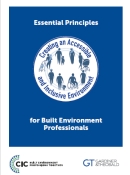Essential principles, Creating an accessible and inclusive environment
The Construction Industry Council (CIC) was established in 1988 to provide ‘…a single voice for professionals in all sectors of the built environment’. It is a forum for professional bodies, research organisations and specialist business associations in the construction industry.
On 9 March 2017, CIC launched: Essential principles, Creating an accessible and inclusive environment. The guide emerged from the Built Environment Professional Education Project, a government project now being taken forward by CIC. It was sponsored by Gardiner & Theobald.
The aim is to build on the legacy of the London 2012 Olympic and Paralympic Games by helping change how inclusive design skills are taught in the UK.
The guide includes six principles to underpin decisions by clients, employers and the wider society which can help create an inclusive environment. The principles were first suggested by the Office for Disability Issues in the Built Environment Professional Education Project Report of Progress published in March 2016:
- Contribute to building an inclusive society now and in the future.
- Apply professional and responsible judgement and take a leadership role.
- Apply and integrate the principles of inclusive design from the outset of a project.
- Do more than just comply with legislation and codes.
- Seek multiple views to solve accessibility and inclusivity challenges.
- Acquire the skills, knowledge, understanding and confidence to make inclusion the norm not the exception.
The guide suggests that:
|
An inclusive environment recognises and accommodates differences in the way people use the built environment. It facilitates dignified, equal and intuitive use by everyone. It does not physically or socially separate, discriminate or isolate. It readily accommodates and welcomes diverse user needs — from childhood to adulthood through to old age, across all abilities and disabilities and embracing every background, gender, sexual orientation, ethnicity and culture. An inclusive environment:
|
The report recommends that all built environment professionals, institutions and related bodies adopt and subscribe to these essential principles for achieving an inclusive environment:
| All built environment professionals have a significant role to play in helping to achieve an accessible and inclusive environment. Whether you are an architect, architectural technologist, town planner, landscape architect, civil, structural or building services engineer, surveyor, interior designer or facilities manager — you have a personal obligation to maintain and enhance your knowledge, skills and competence in your area of practice. |
BEPE Project Board Chair Paul Morrell suggested that the industry should: “…always have in its mind the whole idea of accessibility: of welcoming the greatest possible number of people, in all the many guises we come in, into our buildings and our businesses, and designing into both whatever accommodations may be necessary to make them feel at home. To do that, all we have to do is first to care; then to know what to do; and then just do it..’’
Tony Burton, partner of Gardiner & Theobald said: “By embracing these six principles for achieving an inclusive environment the construction and property industry can achieve the same impressive levels of accessibility we saw in London 2012.”
[edit] Related articles on Designing Buildings Wiki
- Accessibility in the built environment
- Access and inclusion in the built environment: policy and guidance.
- Access audit.
- Access consultant.
- Approved Document M.
- BIFM standard Managing Accessibility and Inclusion.
- Built Environment Professional Education BEPE.
- Changing lifestyles.
- Construction Industry Council.
- Disability Discrimination Act DDA.
- Equality Act.
- Equal opportunities policy.
- Healthy planning policy and monitoring in Southwark and Lambeth.
- Hearing loss and the built environment.
- Inclusive design.
- Lifetime homes.
- Lifetime neighbourhoods.
- People with disabilities.
- Planning transport for people with disabilities as the population ages.
Featured articles and news
A threat to the creativity that makes London special.
How can digital twins boost profitability within construction?
A brief description of a smart construction dashboard, collecting as-built data, as a s site changes forming an accurate digital twin.
Unlocking surplus public defence land and more to speed up the delivery of housing.
The Planning and Infrastructure bill oulined
With reactions from IHBC and others on its potential impacts.
Farnborough College Unveils its Half-house for Sustainable Construction Training.
Spring Statement 2025 with reactions from industry
Confirming previously announced funding, and welfare changes amid adjusted growth forecast.
Scottish Government responds to Grenfell report
As fund for unsafe cladding assessments is launched.
CLC and BSR process map for HRB approvals
One of the initial outputs of their weekly BSR meetings.
Architects Academy at an insulation manufacturing facility
Programme of technical engagement for aspiring designers.
Building Safety Levy technical consultation response
Details of the planned levy now due in 2026.
Great British Energy install solar on school and NHS sites
200 schools and 200 NHS sites to get solar systems, as first project of the newly formed government initiative.
600 million for 60,000 more skilled construction workers
Announced by Treasury ahead of the Spring Statement.
The restoration of the novelist’s birthplace in Eastwood.
Life Critical Fire Safety External Wall System LCFS EWS
Breaking down what is meant by this now often used term.
PAC report on the Remediation of Dangerous Cladding
Recommendations on workforce, transparency, support, insurance, funding, fraud and mismanagement.
New towns, expanded settlements and housing delivery
Modular inquiry asks if new towns and expanded settlements are an effective means of delivering housing.























